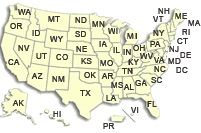Minnesota Water Science Center

UMIS NAWQAUSGS IN YOUR STATEUSGS Water Science Centers are located in each state. 
|
Urban Land Use StudyThe purpose of urban land use studies is to investigate the quality of shallow ground water in urban residential/commercial areas in major municipal areas throughout the U.S. The urban land use study of the Upper Mississippi River Basin Study unit is located in several northwestern suburbs, and including, the City of Minneapolis, Minnesota. Well sample locations can be found on this map.  Figure 1 During the spring of 1996, 30 shallow monitoring wells were drilled for this study (Figure 1). Figure 2 shows the use of a hydraulic hammer for collecting split spoon samples of sediments. Split spoon samples of sediments were collected at depths of 4-6 ft below land surface and at the top 2 feet of the saturated zones.  Figure 2 After drilling, the monitoring wells were developed. Well developing is done to remove clay, silt, and fine sand from the vicinity of well screens, so that water samples are less turbid. Developing of wells involved pumping them with a high-capacity centrifugal pump (Figure 3) and measuring physical parameters, including pH, temperature, turbidity and specific conductance of the water being pumped (Figure 4).  Figure 3 Sampling of these wells was conducted in late June to early July. The sampling uses "parts per billion protocols" which require careful sample collection and equipment decontamination procedures. These methods are used because of the sensitivity of our analyses methods (down to several parts per trillion for many organic constituents) and because of the risk of carry-over of contaminants between wells. Figure 5 shows USGS staff preparing sampling bottle labels and calibrating instruments prior to collecting a water sample.  Figure 4  Figure 5 Water samples collected from the monitoring wells were analyzed for the concentrations of 242 compounds. Many of the water samples from the wells had detectable concentrations of pesticides (Figure 6) and VOC's (Figure 7). Those compounds were detectable in water samples from more than half of the wells (Figure 8, Figure 9). Detected concentrations of these compounds were generally less than 1 microgram per liter (1 part per billion). The most frequently-detected pesticide compounds in water from the wells were the herbicides prometon, atrazine (and its breakdown product deethylatrazine), and terbuthiuron. Prometon and tebuthiuron are herbicides commonly applied to right-of-ways. Atrazine is a herbicide which is commonly applied where corn is grown and which is widely detectable in rainwater and in air in the Midwestern U.S., particularly in the Spring. The most commonly-detected VOC's were carbon disulfide and methyl chloride. Carbon disulfide is emitted by the manufacture of synthetic fibers and may also be created by naturally-occurring bacteria in soils. Methyl chloride may have been created by reactions between naturally-occurring organic substances in the water samples and the hydrochloric acid used to preserve the samples. |